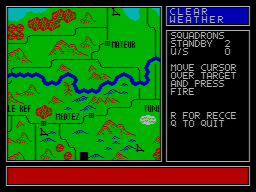Vulcan

CCS, £9.95

There are a lot of readers of FRONTLINE who will need no introduction to the name of RT Smith. He has become one of the few strategy game writers to carry the burden of a reputation, something which I think has worked against game designers in other computer genres. One admired release creates an expectation of something the same only better next time, and if it is different because the author is trying to experiment, the reception can be puzzlement and disappointment.
Vulcan: The Tunisian Campaign is not different. In presentation and game mechanics, it follows quite unashamedly in the tradition of Arnhem and Desert Rats. The format is identical and the system has been refined, rather than changed in any significant way. In his previous two releases, RT Smith developed a ‘look’ for a computer wargame which is extremely viable and, as he’s proving, pretty extendable. Some quibbles I had with the system as used in Desert Rats have been cured, most satisfyingly; it’s now possible, for instance, to survey all your own units, including those stacked together, before giving orders to any of them.
To those familiar with Desert Rats that is all the technical introduction this wargame needs, but for the uninitiated, Vulcan is based firmly on the board games that some of us love. Units are represented by cardboard counters electronically coded — and orders are given to each by means of a menu of options, whether to move, assault, hold, ‘travel’ or fortify. A report can easily be called up for each unit, detailing factors such as strength, supply and attack modifier. When units from each side come into contact, combat automatically occurs. After all the orders have been given by the player, movement on both sides is carried out simultaneously by the computer.
To these basics, air attacks and hidden movement have been added. Air attacks are not always possible, and the choice of using any air strength for reconnaissance instead is available. If the player is too far away from a friendly airfield, the squadron has a good chance of being shot down. Hidden movement is infuriating, but adds greatly to the atmosphere of confusion and tension. When playing against the computer, you are simply unable to see the computer’s ‘counters’ until one of yours makes contact with it. Fortunately, intelligence is limited on both sides; the computer opponent cannot see your counters either, or so the author claims...
The Tunisian Campaign itself is not, as the author admits, one of the best-known of World War II; but as the final objective of the grand-scale scenario makes clear, the ultimate goal is control of Bizerta and Tunis. French Morocco, Algeria and Tunisia belonged to France and fell with her occupation in 1940. The campaign by the Allies to regain the territory began in 1942 and succeeded in 1943. This entire historical campaign can be played through, given a spare fortnight, in the obligatory ‘big scenario’ lasting 183 turns from 12 November 1942 to 13 May 1943. The playing time of The Tunisian Campaign is estimated at 8–16 hours! Alternatively, the game is divided into four shorter scenarios, from 12 to 23 turns. A save game option is provided, of necessity. In the 128K version the entire game is present in memory; 48K owners have to reload data for each scenario when starting a new game.
Five nations take part, and are distinguished by colour. There are ten different types of unit, each with individually-described capabilities and weaknesses. The brigades and divisions are actually named in play, and correspond to historical forces. The supply rules for brigades, divisions and battalions differ, something which I found mildly confusing, particularly so because supply, as in Desert Rats, plays a vital role in attack and defence. Supply is a portable commodity which is used up continually, but at different rates depending on the activity pursued by the unit. Supplies can be replenished by HQ units, which themselves must be near a road with a clear path back to a friendly source. A unit attacking without supplies is at a disadvantage, as, naturally, cutting off an enemy supply source is a very good tactic.
The map is extremely big, far larger than the map of Desert Rats, and has a crisp, functional, attractive appearance. There are 11 terrain symbols listed in the manual, all reasonably clear on the screen, though on my black and white monitor (which is all I can afford on my £1.99 a year grant) I had difficulty distinguishing between ‘rough’ and ‘mountain’. This is important because the manual explains at some length that choice of terrain for the battle can have a significant effect on the outcome. I found it difficult to decide exactly which ‘square’ individual units were on anyway. Because the counters are large and the terrain detailed, this is a perpetual problem.
Combat is hair-raising because of the aural representation of the duration and strength of damage inflicted, one familiar, no doubt, to players of Desert Rats. The 128K version sounds chilling realistic as machine guns rattle and bombs drop somewhere with a whine. Defeated units retreat automatically, but combat is quite often not conclusive in a single round; the damage one, to your own side at least, can be checked in the next round.
The 128K version — which is, incidentally, provided on the reverse side of the same tape as the 48K — includes options to vary the historical situation in each scenario, effectively giving an advantage to one side or the other. The 48K version doesn’t have any skill levels, but this is probably one of the few games which can stand that. It means there’s no easy way in.
The accompanying booklet is as substantial and excellent as its predecessors. The playing sequence is methodically laid out and arranged under subtitles for ease of reference, terrain and unit symbols are illustrated — I wish other writers would realise what a help this is when their idea of a light tank looks like a misshapen fried egg — and the historical background to each scenario is described extensively, with photographs and diagrams to go with it. There’s a print-out of the map in the centre pages, which is helpful when only a small portion of it can be on the screen at one time. This is the kind of documentation which inspires rather than merely tells how to play the game, and I wish more game designers would emulate it.
The same can be said of Vulcan itself. This is Spectrum wargaming at its very best; complex in operation, wide in scope, and easy to use. There’s hours of play in it and I would regard it as an essential purchase for every wargamer.
Presentation 90%
Smooth and uninterrupted
Rules 94%
Voluminous historical information, immaculately presented
Playability 89%
Admirably simple for such a complex game, but sometimes confusing
Authenticity 92%
The amount of detail provided before a single shot is fired builds up the atmosphere
Opponent 85%
Vicious, but disconcertingly invisible for most of the time!
Value for money 94%
Weeks of play
Graphics 89%
Clear, uncluttered and pleasant
Overall 94%
The state of the art in Spectrum wargaming.